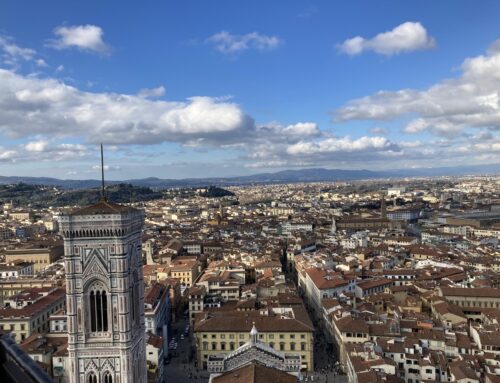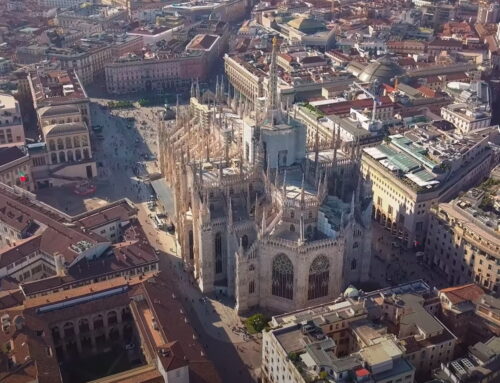Everything you need to know about traveling to Italy
Understandably, Italy is one of the top destinations in the world for travelers. When you consider the history, scenery, architecture, culture and food, there is really no other destination that compares.
We put this guide together for travelers who have their sights set on this beautiful country.
Let’s get to it!
Italy location and geography
Italy is a medium sized country contained within a total of about 116,000 square miles, or just over 300,000 square kilometers. This ranks Italy 71st in the world in terms of land mass. It is a part of the European continent.

Italy shares a border with Switzerland and Austria to the north, France to the northwest and Slovenia to the northeast. Within the Italian mainland, there are two enclaves… Vatican City and San Marino.
Much of the country is a peninsula jutting out of the European continent into the greater Mediterranean Sea.
The Mediterranean is then made up of smaller seas, and Italy is bordered by several.
The east coast of Italy is bordered by the Adriatic Sea, which separates Italy from countries such as Croatia, Albania and Greece to the east.
On the west coast, Italy is bordered by the Ligurian Sea and Tyrrhenian Sea. The Tyrrhenian Sea then borders the north coast of Sicily.
The south coast of the Italy mainland, also known as the boot of Italy, is bordered by the Ionian Sea, which also borders the east coast of Sicily.
Some of the Italian land area is contained on a number of islands. Sicily and Sardinia are two of these islands, and are the largest islands in the Mediterranean Sea.
There are then a number of smaller islands included in Italy’s geography, such as Capri, Lampedusa, Stromboli, and Elba, among others.

Stromboli Volcano
Much of Italy is volcanic in origin, and many of the small islands are volcanic. Active volcanoes in Italy include Mt. Etna on Sicily, Vulcano, Stromboli and Vesuvius. Vesuvius, located near Naples, is the only active volcano on the European mainland.
Much of the topography in Italy is mountainous. The Appenine Mountains run through the center of the Italian peninsula. The Alps form most of Italy’ northern boundary, and the Dolomites form the northeastern boundary.
Mont Blanc is the highest peak in Italy at over 15,700 feet, and is located in the Alps.
Italy is known for several beautiful lake areas. Three of these are in northern Italy, and these are also the largest lakes in Italy… Garda, Maggiore and Como. Lakes Trasimeno and Bolsena closer to Rome round out the five largest lakes in Italy.
There are 16 rivers with a length of 100 miles or more. The longest of these is the Po River, which originates in the Alps and ends in the Adriatic Sea and has a length of 405 miles.
The Tiber River, which runs through Rome, is the third longest river in Italy with a length of just over 250 miles.
Italy Climate

Sicily wildfires
Because Italy extends quite a distance in latitude from north to south (over 700 miles), the climate across regions of Italy can vary significantly.
Winters in the northern regions can be quite cold with average temperatures of about freezing in the Alps and up to 54 degrees in Sicily.
Summer temperatures can range from warm in the northern regions to brutally hot in the low land areas of the mainland and in Sicily.
Sicily is notably quite dry and the island is prone to wildfires during the heat of the summer.
Due to the presence of the Mediterranean and the wall formed by the mountain ranges to the north, the areas along the coast of the mainland typically experience more mild winters and cooler summers than the interior areas of the mainland.
Regions of Italy
The regions of Italy are the first level administrative divisions of the Italian Republic. There are twenty such regions of Italy, and under the Italian Constitution, each is an autonomous entity.
Five of the regions have been granted “home rule” ie, government of the region by the citizens of that region.
These regions were given this designation to account for cultural differences or to protect linguistic minorites.
This designation was also granted to keep each of the regions from seceding from the Republic after Italy’s defeat in World War II.
These five regions include Sicily, Sardinia, Aosta Valley, Friuli Venezia Giulia, and Trentino-Alto Aldige/Sudtirol.
Here is a list of all twenty regions and their capitals:

Scene from Piedmont Region

Vistors to Italy by Region
Abruzzo – L’Aquila
Aosta Valley – Aosta
Apulia – Bari
Basilicata – Potenza
Calabria – Catanzaro
Campania – Naples
Emilia-Romagna – Bologna
Friuli Venezia Giulia – Trieste
Lazio – Rome
Liguria – Genoa
Lombardy – Milan
Marche – Ancona
Molise – Campobasso
Piedmont – Turin
Sardinia – Cagliari
Trentino-Alto Aldige/Sudtirol – Trento
Umbria – Perugia
Veneto – Venice
And of course, the capital of Italy is Rome.
What you should know before you go to Italy
Here are some tidbits that you should know before traveling to Italy, from the obvious to the not-so-obvious.
Currency: Euro
Language: Italian of course. In many of the big tourist areas, English is spoken by many people in the hospitality industry, but not necessarily in the restaurants. We highly recommend that you learn some Italian before you go. Many Italians will appreciate the effort. Rosetta Stone is a popular app for learning Italian.
Visa Requirements: For stays under 90 days, you do not need a Visa, but you will need your passport.
Electricity: Europe has different electrical outlets than what we have here in the US, so you will need an adapter.
Car Rentals: If you intend to visit small towns while in Italy, you will want to rent a car… it is simply the easiest way to get around. You’ll need an international driver permit along with your driver’s license. If you do not have an international driver’s permit, head on over to your nearest AAA office.
For finding the best deals on rental cars, check out Discover Cars.
Flying to Italy: Flying to Italy from North America does have its difficulties. Check out our tips for flying to Italy.
The major airports are found in Rome, Milan, Bologna, Naples, Venice and Bari on the mainland; Cagliari on Sardinia; and Palermo and Catania on Sicily.
If you are looking for a driving service for transfers to and from the airport, check out Kiwi Taxis. They provide service from the major airports in Rome, Milan, Venice, etc.
The Trains: Public transportation is how most Italians get around, whether by train or bus. In our view, the trains are a great way to go between the major cities, as you get great views of the Italian countryside.
With that said, the regional trains between the smaller towns can get quite crowded and they have no assigned seats so just be prepared for some chaos when traveling on these trains.
They also run much more slowly than the high speed trains, and are often not on schedule, so you may also need to be a bit patient.
Travel Insurance: Anytime you plan on a trip overseas, you should consider purchasing travel insurance. Travel insurance can cover the cost of medical emergencies, lost baggage, unexpected trip cancellations, etc.
Travel Insurance Master can help you find the coverage you need for your trip.
When is the best time to go to Italy?
This depends entirely upon your primary activity and where you intend to go.
Naturally, if skiing is on your agenda, you want to go in the winter months, although early Spring can still work in the Alps.
If tourism and sightseeing will be your primary activities, and destinations such as Rome, Florence and Sicily may be on your agenda, then you’ll want to avoid those places in July and August due to the potential for extreme heat and crowds.
A word on the crowds… we traveled to Florence and Rome in late January to early February in 2023 and it was still crowded in both cities. Temperatures were slightly below normal when we were there, particularly in Florence, so it was chilly.

Florence in January 2023 – a little chilly!
If you are heading to any coastal areas, again, it is best to avoid July and August as the beaches can be insanely crowded. Otherwise, you will want to venture off the beaten path to find a more secluded beach. However, those will come with fewer amenities and facilities.
In general, April and May as well as September and October are the best months to visit most areas in Italy due to slightly smaller crowds, and more comfortable temperatures.
We mention slightly smaller crowds because most of Europe knows these are the best weather months to visit Italy as well.
If golf is a primary activity, Summer is the best season to go in northern Italy as the Summer temperatures are cooler there than further south.
Otherwise, golf in areas closer to Rome, Florence and Sicily is better in Spring and Fall.
Major Italy Destinations
Some of the major destinations in Italy include the obvious ones… Rome, Florence, Milan, Venice and Naples. Those are the big 5 cities of Italy. You can build a vacation around all of them.
Sicily is another must see destination of Italy. Unless you plan on multiple trips, you should spend at least ten to twelve days there to spend a decent amount of time in the major areas… Palermo, Cefalu, Taormina, Syracuse, and Agrigento.
Because these areas of Sicily are spread out across the island, it takes time to reach them all, and travel time can eat into your site seeing. This is why you’ll need to give yourself time to visit.
Sardinia is another major destination. While the capital, Cagliari is on the south coast, most attention is paid to the Costa Smeralda on the north coast.
Costa Smeralda is closer to Europe and has more resorts catering to visitors seeking an escape to the beaches. With that said, you can find spectacular beaches around the entire island, so it is worth taking a trip to explore the entire island.

Costa Smeralda in Sardinia
While not on the radar for many North Americans and Europeans, the Apulia region forming the heel of Italy’s boot is also a popular destination for beach goers.
North of Milan is also known as the Italian Lake region due to the presence of Lake Como, Lake Maggiore and Lake Garda. These are very popular destinations among Italians and Europeans alike due to the beautiful small towns that sit on the shores of each lake.
Speaking of the most beautiful small towns in Italy, we can’t forget about the eastern Italian Riviera. The area stretching from Portofino down to Lerici is dotted with some of the most beautiful coastal towns in Italy, including the Cinque Terre.
If you are looking for the perfect postcard photo, you’ll have numerous opportunities along this part of the Ligurian coast.
Of course, we can’t forget all of the small towns located between Rome and Florence in the Lazio, Umbria and Tuscany regions. There are too many to list here, but Passignano sul Trasimeno, Montepulciano, and Montalcino are three you don’t want to miss.
And, for the foodies among us, a true Italian culinary trip is nowhere near complete without a stay in Bologna.
As you can very well see, you can probably spend a lifetime exploring all the riches offered by this beautiful country. If you’ve never been there, it’s time to go!





